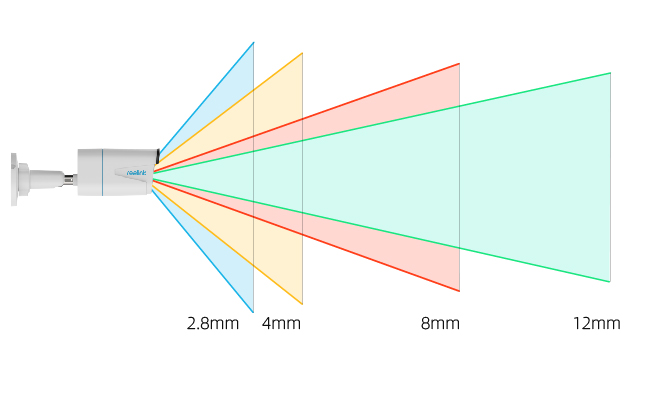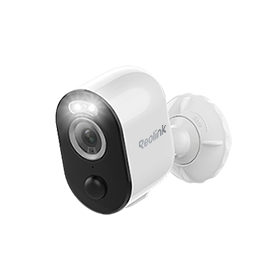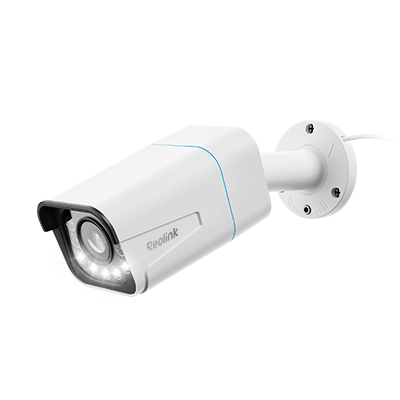Understanding the security camera lens can be a tricky process. Though the numbers listed with the security camera lens seem simple enough, it is more confusing to know the implications behind those numbers.
To get the best picks for security camera lenses, it is important to gain an insight into their types and essential factors first. Now continue reading to learn how you can choose the right security camera lens and find the best security cameras with wide angle lens/varifocal lens that suit you most.
A Detailed Explanation of CCTV Camera Lens Types
In a nutshell, CCTV security camera lenses can be divided into two major types: fixed lenses (also called mono-focal lenses) and varifocal lenses, according to their capability of adjusting the focal length.
Fixed lens vs. varifocal lens
Fixed lens: The focal length of a fixed lens CCTV security camera is permanently set, meaning the field of view cannot be changed once the camera is installed. Also, the image size will remain the same regardless of the distance between the object and the camera.
Varifocal lens: A varifocal lens security camera allows you to adjust the focal length for your specific needs. You can zoom in to see a closer view for more details or zoom out to get a wider view of the area. For this advanced feature, varifocal lenses tend to be more expensive than fixed lenses.
Wide-angle lens vs. telephoto lens
Fixed lenses consist of two categories: wide-angle lenses and telephoto lenses, which have different focal lengths.
A wide-angle lens has a short focal length and can capture a wider field of view than a normal lens. Typically, security cameras with a 2.8mm lens can be regarded as wide-angle cameras as they can offer about 100° wide viewing angle. There is also a special kind of wide-angle camera that utilizes dual lenses to cover a 180° wide view.
Telephoto lenses, in contrast to wide-angle lenses, have long focal lengths and are designed to capture distant subjects with great clarity and detail. They are often used to monitor narrow areas such as hallways.
As wide-angle lenses and telephoto lenses have their own pros and cons, some manufacturers manage to combine them together and make the most out of them. Reolink TrackMix can be a great example as it has a wide-angle lens to cover a large area and also a telephoto lens to provide far-away details.
Manual zoom lens vs. Motorized zoom lens
Varifocal lenses can be further divided into two kinds: manual zoom lenses and motorized zoom lenses . Manual zoom lenses require users to adjust the focus of the lens on their own by turning a dial or moving a switch, while motorized zoom lenses can automatically adjust the focal length of the camera to get clear auto-focused images.
Among varifocal lens CCTV security cameras, most are equipped with motorized zoom lenses for convenient operation, such as PTZ security cameras. Users can adjust the zoom via mobile software or desktop client.
Comparison of the major two types of security camera lens
Here is a table showing you the differences between fixed lens and varifocal lens security cameras , including their applications.
How to Select Security Camera Lens - 5 Must-Know Factors
When it comes to choosing the right security camera lens, there are a few key factors that should be taken into consideration.
1. Focal Length
The security camera lens size, or focal length, refers to the distance from the center of the lens to the point at which light rays coming from an object converge, and it is measured in millimeters (mm). It is an important term for camera lens and affects the field of view.
In short, the shorter the security camera lens focal length is, the wider area you can see but with fewer details; the longer the focal length, the further you can see but with a narrower viewing angle.
For example, Reolink security camera RLC-810A with a 2.8mm fixed lens can see 101° horizontally and 30 meters away at night, while RLC-810A with a 6.0mm lens offers a 53° horizontal view and a 40 meters night vision range.
The focal length of a lens can range from 2mm to 100mm, but the common focal length for fixed-lens security cameras is 2.8mm, 4mm, 6mm, and 12mm. As for varifocal-lens security cameras, the most common focal length will be 2.8-12mm or 2.7-13.5mm.

Wide-angle security cameras with a focal length of 2.8mm or shorter work best for large areas such as parking lots, backyards, warehouses, construction sites, etc. Security cameras with a long focal length of 8mm or more are ideal for critical entrances, like doorways, hallways, cash registers, etc.
2. Aperture
Aperture refers to the size of the opening in which light can pass through, and it is measured in F-stops as values increase or decrease.
One thing to keep in mind is that a lower number of F-stops represents a wider aperture. For example, F1.4 is a large aperture and allows for more light to pass into the camera.
The aperture is a significant term for security camera lenses because it can affect the camera’s depth of field — the distance between the nearest and farthest objects in a scene that appears sharp in an image.
The narrow aperture corresponds with a large depth of field, which contributes to more objects captured in focus.
Hint: Some security cameras allow you to control how much of a scene is in focus by adjusting the security camera lens aperture. A wide aperture will make objects in front of you well-focused but the background blurry. Whereas a small aperture will lead to everything being captured in focus.
3. Iris
The iris controls how much light comes through a lens's aperture. When the iris creates a large opening, more light can pass through.
However, it is not the case that the wider the iris, the better images you can get. Too much light can wash out your video and little light will make the scene dark.
So it is vital to pick up a suitable iris type for your purpose. The fixed and manual iris lenses are typically used for an indoor environment where the light stays consistent, such as an office, school, or shop.
The auto iris lens, on the other hand, can automatically adjust light changes and is ideal for outdoor locations where there are light variations.
Thus, it's important to think about where you are going to position the security cameras before investing in the security cameras. The indoor or outdoor position will influence the final iris types you pick up.
4. Camera Format
When you look at the listed specification of security camera lenses, you will notice the numbers such as 1/2", 1/3", 2/3", and 1/4" for the image sensors.
Generally speaking, the smaller the image sensor is, the narrower the security camera's field of view is. For example, a 2/3” image sensor will see wider than a 1/3” one.
That’s the format size of security cameras we are talking about. For lens format size, note that the lenses’ image format, say “2/3 inch image format”, is the maximum size it will allow.
So bear in mind that the format size of a security camera lens should be equal to or greater than that of cameras, otherwise the corners of the scene being viewed will be cut off.
Remember to double-check the format size of both security cameras and lenses and follow the rule above to get a great shot.
5. C or CS Mount
C and CS mount are two available options when it comes to mounting a lens to a CCTV security camera. Their main differences lie in the distance from the image sensor to the lens.
The distance for C Mount is 17.5 mm while the CS Mount is 12.5 mm.
When selecting the lens for security cameras, check whether the lens and security cameras allow for C Mount or CS mount. Not having a matching lens could be responsible for the inferior images of security cameras.
Best Security Cameras with Fixed/Varifocal Lens
Looking for a wide-angle or high-resolution security camera? Here we’ve rounded up some best security cameras with a fixed wide-angle lens or varifocal lens. And each one comes with rich features for your home or business security.
1. Battery/solar-powered security camera with fixed lens - Argus 3 Pro
Reolink Argus 3 Prois now the most popular battery/solar-powered security camera with a fixed lens.
2K 100% Wire-Free Spotlight Camera
2K 4MP Super HD, Battery/Solar Powered, Person/Vehicle Detection, 5/2.4 GHz Dual-Band WiFi, Color Night Vision, Two-Way Audio.
With a 1/3'' CMOS sensor, this security camera can capture 2K 4MP super HD images and provide a 122° diagonal wide viewing angle. There are also built-in spotlights for the camera to keep recording in full color both day and night.
By cutting all wires, you can install this fixed-lens security camera indoors & outdoors to monitor the critical entrances or the sites without power supply, such as the barn, farm, front door, back door, backyard, etc.
2. Best PoE security camera with varifocal lens - RLC-811A
With the 1/2.8" CMOS sensor and 2.7-13.5mm varifocal lens, Reolink RLC-811A stands out as the best quality PoE security camera, featuring up to 105° field of view horizontally and up to 55° vertically.
4K Smart PoE Camera with 5 Spotlights
4K 8MP Ultra HD Day & Night, Person/Vehicle Alerts, 5X Optical Zoom, Two-Way Audio, Built-in Siren, Color Night Vision, Live View Anywhere.
It has 4K 8MP ultra-high resolution and offers your more than crystal-clear pictures. Better yet, the 5X optical zoom enables you to have a clear view whether you want to have a wide view or see details far away.
As a solid security camera, RLC-811A has onboard smart detection. It can send precise alerts to your mobile phone when detecting a person, vehicle, or pet dog. Without any subscription fees, you can get accurate and intelligent alerts.
3. Best PTZ security camera with 360° wide angle - Reolink TrackMix WiFi
If you need a security camera to cover a large area like a parking lot, Reolink TrackMix WiFi with 355° & 90° tilt is perfect as it can also provide a 360° view without blind spots.
4K Dual-Lens PTZ Camera with Motion Tracking
4K 8MP UHD, Wide-Angle & Telephoto Lenses, Pan-Tilt-Zoom, Auto-Tracking, Person/Vehicle Detection, 2.4/5 GHz Dual-Band WiFi, Two-Way Audio.
This 4K 8MP PTZ camera has a wide-angle lens for a broad view and a telephoto lens for close-ups. You can get two different views at the same time. Moreover, Reolink TrackMix WiFi can automatically track a moving person or vehicle in sight, so you'll never miss any important moment.
How to Clean Security Camera Lenses
The dirt, dust, or spiderwebs on your security camera lens could lead to distorted and blurry images. To get the most out of your security cameras, follow the handy tips below to clean your CCTV security camera lens on a regular basis, say, twice a year for optimal performance.
Step 1: Shut off your CCTV camera systems before you start to clean the security camera lenses, for fear that you should accidentally spoil the electronic system.
Step 2: Use a can of compressed air and blow air at the lens to clean the dirt, dust, or loose debris accumulated on the security camera lens.
Step 3: Wipe the CCTV camera lens with a piece of soft microfiber cloth to avoid scratches on the sensitive lens surface.
Step 4: Utilize a small dash of security camera lens cleaner on your micro-fiber cloth, and then wipe the lens gently. Or you can breathe onto the CCTV camera lens instead of using a lens cleaner.
Bonus Tip: Want to keep bugs/spiders or webs off your security camera lens? Read this post to gain more practical ideas about how to protect your security camera.
FAQs
What lens is used in security cameras?
Typically, the lenses used in security cameras fall into two categories: fixed or varifocal. Fixed lenses have a fixed focal length and field of view that don't change, while varifocal lenses come with an adjustable focal length and have different fields of view. Either type of lens can be used depending on your specific needs.
What lens is good for surveillance?
This depends a lot on your surveillance needs. High-resolution like 2K or 4K camera lenses are recommended as they can give you crystal-clear images and more details.
Also, you should consider how many fields of view are needed. For example, a wide-angle lens with a short focal length can cover more areas while those with a long focal length are designed to capture things clearly far away in a narrow FOV. If you want both a wide view and clear details, varifocal lenses can meet your surveillance needs.
What is the difference between a 2.8 and a 4mm lens?
2.8mm and 4mm lenses are commonly used in security cameras, and their main differences lie in the angle of view that they can provide.
Generally speaking, a 2.8mm lens offers a wider field of view between 90-110 degrees. A 4mm lens has an angle of view of 60 to 80 degrees, which is still considered wide but not as extreme as the 2.8mm option. Meanwhile, a 4mm lens can see further than a 2.8mm lens, but not very much.
Conclusion
With a host of the security camera lens in the market, the best approach is to do your research before rushing into a shop and being taken in by what the sellers advertise.
If you still have any problems selecting the right security camera lenses, please don’t hesitate to leave a comment below!




